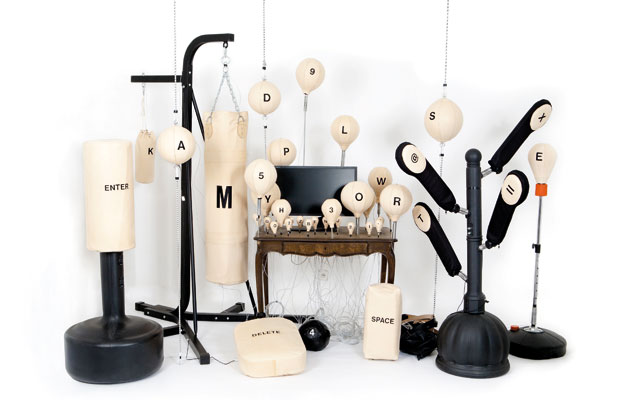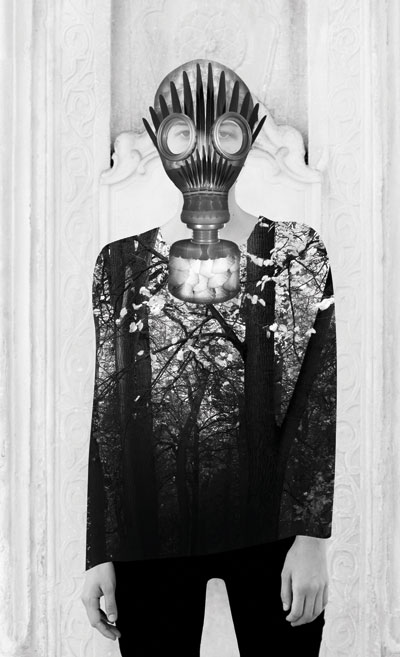|
The Workout Computer by Desiree Heiss and Ines Kaag of Bless |
||
|
This year found designers in apocalyptic, survivalist mood, argues Christopher Turner The 2nd Istanbul Design Biennial, of modest size, wasn’t a city-wide event, but occupied the scuffed, institutional interior of a former Greek primary school in Karaköy, which had been carved in two with fabric banners by local firm Superpool. British curator Zoë Ryan borrowed her title from an aphorism by the symbolist poet Paul Valéry: “The trouble with our times is that the future is not what it used to be.” The statement was intended as a provocation, but is at the same time full of nostalgia, evoking as it does a sad world of battered dreams. In his memoir, Istanbul: Memories and the City (2003), the Nobel laureate Orhan Pamuk refers to this feeling as hüzün, a communal melancholy which he believes defines Istanbul. Its inhabitants, he says, live “at a ruined crossroads, struggling to be modern, yet still to retain the dignity of their past.” He writes about the paralysis such a feeling induces in the local populace, or rather the “poetic license [it gives] to be paralysed”. Many of Ryan’s commissions, or manifestos, had a similarly apocalyptic, defeated air. Jessica Charlesworth and Tim Parsons, for example, exhibited a series of “bug-out bags”, survivialist kits kept in case of evacuation. They were evocative time capsules, designed for distinct personalities, that conjured up different images of a makeshift future.(The Decision Maker included a pinstriped suit whose many pockets were filled with fortune-telling aids; The Re-wilder had a rucksack with guides on how to make flint and stone tools.) Together, they had the same enigmatic valence as the Cornell-like boxes with which Pamuk has stuffed his Museum of Innocence in the nearby Beyoglu district of Istanbul. Dunne & Raby presented sketches elaborating on their exhibition United Micro Kingdoms, commissioned by the Design Museum in 2013, which also depicted a taxonomy of the nomadic inhabitants of an alternative near-future (the Digitarians, Communo-Nuclearists, Anarcho-Evolutionists and Bioliberals).
Designer gasmasks by Meriç Canatan and Fatosh Erhuy The biennial’s abiding vision of the world of tomorrow was more DIY than sci-fi. Dutch collective Repair Society set up a stall to fix visitors’ broken possessions. Mischer’Traxler invented a manual and toolkit that allowed you to create your own blanket from sheep’s wool or paper from plant pulp. There was also a kit by Mansour Ourasanah in which you could cultivate grasshoppers for table, and another by Turkish designers Koz Suzani that enabled you to create meals from flavoured pills. This was design taken completely back to basics. Perhaps the most intriguing exhibit was by Malkit Shoshan, Marina Otero and Ethel Baraona, who was associate curator of Joseph Grima’s Adhocracy exhibition for the biennial’s first edition. Taking their cue from the testimony of a woman describing a life under the constant threat of drone attacks, they showed a wall covered with rip-off sheets featuring a lexicon that conjured the paranoid withdrawal from civic life; from Algorithm to WTSHTF (When the shit hits the fan), from bin Laden’s cowboy hat to the CIA’s Kill List. Only a few exhibits seemed to engage with Istanbul itself, a city that earlier this year seemed on the brink of great political change. Studio Bow-Wow exhibited a huge drawing, done with local students, that presented an ethnography of Galata Bridge with its many fishermen (see page 130), Sissel Tolaas created one of her smell maps of the city, and Architecture for All documented the now dismantled protest architecture of Gezi Park with its many makeshift barricades. 2nd Istanbul Design Biennial: The Future is Not What it Used to Be took place in various locations around Istanbul from 1 November to 14 December 2014 |
Words Christopher Turner
Images: Bless; Birdy Accessories |
|
|
||





















